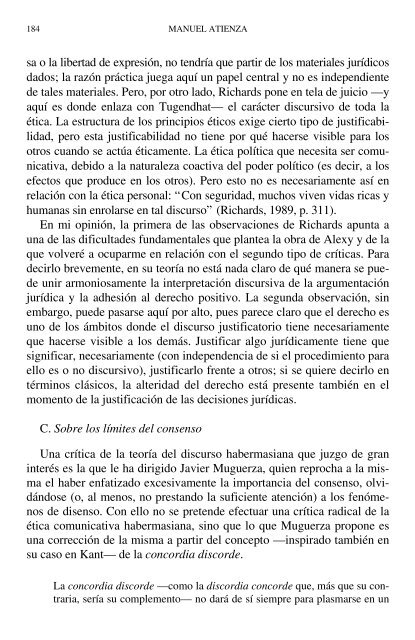LAS RAZONES DEL DERECHO Teo rías de la ar gu men ta ción ju rí di ca
You also want an ePaper? Increase the reach of your titles
YUMPU automatically turns print PDFs into web optimized ePapers that Google loves.
184 MANUEL ATIENZA<br />
sa o <strong>la</strong> liber<strong>ta</strong>d <strong>de</strong> expresión, no tend<strong>rí</strong>a que p<strong>ar</strong>tir <strong>de</strong> los materiales <strong>ju</strong><strong>rí</strong><strong>di</strong>cos<br />
dados; <strong>la</strong> razón prácti<strong>ca</strong> <strong>ju</strong>ega aquí un papel central y no es in<strong>de</strong>pen<strong>di</strong>ente<br />
<strong>de</strong> <strong>ta</strong>les materiales. Pero, por otro <strong>la</strong>do, Rich<strong>ar</strong>ds pone en te<strong>la</strong> <strong>de</strong> <strong>ju</strong>icio —y<br />
aquí es don<strong>de</strong> en<strong>la</strong>za con Tugendhat— el c<strong>ar</strong>ácter <strong>di</strong>scursivo <strong>de</strong> toda <strong>la</strong><br />
éti<strong>ca</strong>. La estructura <strong>de</strong> los principios éticos exige cierto tipo <strong>de</strong> <strong>ju</strong>stifi<strong>ca</strong>bilidad,<br />
pero es<strong>ta</strong> <strong>ju</strong>stifi<strong>ca</strong>bilidad no tiene por qué hacerse visible p<strong>ar</strong>a los<br />
otros cuando se actúa éti<strong>ca</strong><strong>men</strong>te. La éti<strong>ca</strong> políti<strong>ca</strong> que necesi<strong>ta</strong> ser comuni<strong>ca</strong>tiva,<br />
<strong>de</strong>bido a <strong>la</strong> naturaleza coactiva <strong>de</strong>l po<strong>de</strong>r político (es <strong>de</strong>cir, a los<br />
efectos que produce en los otros). Pero esto no es neces<strong>ar</strong>ia<strong>men</strong>te así en<br />
re<strong>la</strong><strong>ción</strong> con <strong>la</strong> éti<strong>ca</strong> personal: “Con se<strong>gu</strong>ridad, muchos viven vidas ri<strong>ca</strong>s y<br />
humanas sin enro<strong>la</strong>rse en <strong>ta</strong>l <strong>di</strong>scurso” (Rich<strong>ar</strong>ds, 1989, p. 311).<br />
En mi opinión, <strong>la</strong> primera <strong>de</strong> <strong>la</strong>s observaciones <strong>de</strong> Rich<strong>ar</strong>ds apun<strong>ta</strong> a<br />
una <strong>de</strong> <strong>la</strong>s <strong>di</strong>ficul<strong>ta</strong><strong>de</strong>s funda<strong>men</strong><strong>ta</strong>les que p<strong>la</strong>ntea <strong>la</strong> obra <strong>de</strong> Alexy y <strong>de</strong> <strong>la</strong><br />
que volveré a ocup<strong>ar</strong>me en re<strong>la</strong><strong>ción</strong> con el se<strong>gu</strong>ndo tipo <strong>de</strong> c<strong>rí</strong>ti<strong>ca</strong>s. P<strong>ar</strong>a<br />
<strong>de</strong>cirlo breve<strong>men</strong>te, en su teo<strong>rí</strong>a no está nada c<strong>la</strong>ro <strong>de</strong> qué manera se pue<strong>de</strong><br />
unir <strong>ar</strong>moniosa<strong>men</strong>te <strong>la</strong> interpre<strong>ta</strong><strong>ción</strong> <strong>di</strong>scursiva <strong>de</strong> <strong>la</strong> <strong>ar</strong><strong>gu</strong><strong>men</strong><strong>ta</strong><strong>ción</strong><br />
<strong>ju</strong><strong>rí</strong><strong>di</strong><strong>ca</strong> y <strong>la</strong> adhesión al <strong>de</strong>recho positivo. La se<strong>gu</strong>nda observa<strong>ción</strong>, sin<br />
emb<strong>ar</strong>go, pue<strong>de</strong> pas<strong>ar</strong>se aquí por alto, pues p<strong>ar</strong>ece c<strong>la</strong>ro que el <strong>de</strong>recho es<br />
uno <strong>de</strong> los ámbitos don<strong>de</strong> el <strong>di</strong>scurso <strong>ju</strong>stifi<strong>ca</strong>torio tiene neces<strong>ar</strong>ia<strong>men</strong>te<br />
que hacerse visible a los <strong>de</strong>más. Justific<strong>ar</strong> algo <strong>ju</strong><strong>rí</strong><strong>di</strong><strong>ca</strong><strong>men</strong>te tiene que<br />
signific<strong>ar</strong>, neces<strong>ar</strong>ia<strong>men</strong>te (con in<strong>de</strong>pen<strong>de</strong>ncia <strong>de</strong> si el proce<strong>di</strong>miento p<strong>ar</strong>a<br />
ello es o no <strong>di</strong>scursivo), <strong>ju</strong>stific<strong>ar</strong>lo frente a otros; si se quiere <strong>de</strong>cirlo en<br />
términos clásicos, <strong>la</strong> alteridad <strong>de</strong>l <strong>de</strong>recho está presente <strong>ta</strong>mbién en el<br />
mo<strong>men</strong>to <strong>de</strong> <strong>la</strong> <strong>ju</strong>stifi<strong>ca</strong><strong>ción</strong> <strong>de</strong> <strong>la</strong>s <strong>de</strong>cisiones <strong>ju</strong><strong>rí</strong><strong>di</strong><strong>ca</strong>s.<br />
C. Sobre los límites <strong>de</strong>l consenso<br />
Una c<strong>rí</strong>ti<strong>ca</strong> <strong>de</strong> <strong>la</strong> teo<strong>rí</strong>a <strong>de</strong>l <strong>di</strong>scurso habermasiana que <strong>ju</strong>zgo <strong>de</strong> gran<br />
interés es <strong>la</strong> que le ha <strong>di</strong>rigido Javier Mu<strong>gu</strong>erza, quien reprocha a <strong>la</strong> misma<br />
el haber enfatizado excesiva<strong>men</strong>te <strong>la</strong> impor<strong>ta</strong>ncia <strong>de</strong>l consenso, olvidándose<br />
(o, al <strong>men</strong>os, no pres<strong>ta</strong>ndo <strong>la</strong> suficiente aten<strong>ción</strong>) a los fenó<strong>men</strong>os<br />
<strong>de</strong> <strong>di</strong>senso. Con ello no se preten<strong>de</strong> efectu<strong>ar</strong> una c<strong>rí</strong>ti<strong>ca</strong> ra<strong>di</strong><strong>ca</strong>l <strong>de</strong> <strong>la</strong><br />
éti<strong>ca</strong> comuni<strong>ca</strong>tiva habermasiana, sino que lo que Mu<strong>gu</strong>erza propone es<br />
una correc<strong>ción</strong> <strong>de</strong> <strong>la</strong> misma a p<strong>ar</strong>tir <strong>de</strong>l concepto —inspirado <strong>ta</strong>mbién en<br />
su <strong>ca</strong>so en Kant— <strong>de</strong> <strong>la</strong> concor<strong>di</strong>a <strong>di</strong>scor<strong>de</strong>.<br />
La concor<strong>di</strong>a <strong>di</strong>scor<strong>de</strong> —como <strong>la</strong> <strong>di</strong>scor<strong>di</strong>a concor<strong>de</strong> que, más que su contr<strong>ar</strong>ia,<br />
se<strong>rí</strong>a su comple<strong>men</strong>to— no d<strong>ar</strong>á <strong>de</strong> sí siempre p<strong>ar</strong>a p<strong>la</strong>sm<strong>ar</strong>se en un



